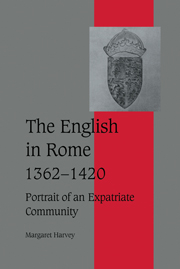Book contents
- Frontmatter
- Contents
- Acknowledgements
- List of abbreviations
- Maps
- Introduction
- 1 The setting I: Rome in the later fourteenth century, 1362–1376
- 2 The setting II: Rome, 1376–1420
- 3 S Thomas's hospice
- 4 S Chrysogonus' hospice and other enterprises
- 5 The laity in Rome
- 6 Women
- 7 The English in the curia 1378–1420: I
- 8 The English in the curia 1378–1420: II
- 9 The career of John Fraunceys
- 10 Adam Easton, an English cardinal: his career
- 11 Adam Easton's ideas and their sources
- 12 Conclusion
- Bibliography
- Index
- Cambridge Studies in Medieval Life and Thought Fourth Series
1 - The setting I: Rome in the later fourteenth century, 1362–1376
Published online by Cambridge University Press: 28 July 2009
- Frontmatter
- Contents
- Acknowledgements
- List of abbreviations
- Maps
- Introduction
- 1 The setting I: Rome in the later fourteenth century, 1362–1376
- 2 The setting II: Rome, 1376–1420
- 3 S Thomas's hospice
- 4 S Chrysogonus' hospice and other enterprises
- 5 The laity in Rome
- 6 Women
- 7 The English in the curia 1378–1420: I
- 8 The English in the curia 1378–1420: II
- 9 The career of John Fraunceys
- 10 Adam Easton, an English cardinal: his career
- 11 Adam Easton's ideas and their sources
- 12 Conclusion
- Bibliography
- Index
- Cambridge Studies in Medieval Life and Thought Fourth Series
Summary
This study begins in Rome in 1362 largely because that year a significant English institution was begun. It is also, however, a reasonable starting point because the year afterwards the city of Rome received a new constitution, intended to mark a decisive shift from the aristocratically dominated politics of the previous period; a new era was about to begin, dominated by the popolo.
Nowadays if one wanders along the via Monserrato from the direction of S Peter's, one comes eventually to a large building on the left side, not far from Piazza Farnese. There is a sizeable church and two large entrances, with inside a complex of buildings of different ages, including a courtyard and a garden, with a smaller chapel. All this and formerly much more is now the Venerabile Collegio Inglese, once the site of the English hospice of S Thomas, now in rione Regola, then called Arenula. The object of this chapter is to answer a few questions about the physical and economic setting in which the new enterprise was undertaken in 1362 and to sketch the background to its first fifty years. By 1420 the enterprise was important and the English had even founded a second hospice, in the Trastevere district, both operations involving substantial ownership of property and a considerable turnover of money.
- Type
- Chapter
- Information
- The English in Rome, 1362–1420Portrait of an Expatriate Community, pp. 10 - 30Publisher: Cambridge University PressPrint publication year: 2000



